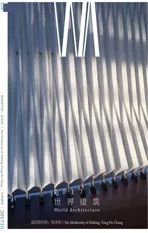席殊书屋,北京,中国
2017-10-20周榕,CHENYuxiao
核心:向后
席殊书屋,北京,中国
Xishu Bookstore, Beijing, China, 1996
评论
周榕:本来无一物——追忆作为思想基因的席殊书屋
在任何一个学科生态中,从思想基因层面影响甚至改变整个生态系统演化进程的历史机遇都颇为罕见。而1996年张永和设计的席殊书屋,就历史性地承担了为中国当代建筑提供“重启型”思想基因的生态革新使命。
1990年代中期,正值中国社会被“第二次改革开放”浪潮席卷激荡、中国建筑界人心思变却苦于找不到新思维与新方法工具的转折当口,席殊书屋这一不足200m2“违章建筑”的设计建成,立刻对中国当代建筑产生了“核爆级”的观念冲击力。
要理解席殊书屋独特的历史贡献,就必须将其放置回20年前中国建筑那个特定的时代语境中去——席殊书屋诞生之日,正值“中国式后现代主义”大行其道之时。所谓“中国式后现代主义”,实质上是打着“后现代”旗号的现代折衷主义和庸俗手法主义。彼时耽湎于“后现代”浅表符号游戏的中国建筑界,长期以来缺乏将建筑问题推进到本体层面思考与讨论的内生型原动力。此时席殊书屋的横空出世,无疑具有不可估量的启蒙价值。
作为张永和第一个真正意义上的建成作品,席殊书屋堪称是一部集中展现其世界观和建筑思想的空间教科书。简要说来,张永和的世界观是后现代的——纠缠于多元、富集、矛盾、复杂的跨界欲望与混搭趣味;而他的建筑思维却遵循苛刻到近乎原教旨的现代性乌托邦信条——纯化的虚构本体、一元的价值体系、抽象的视觉形式、自洽的逻辑推演、致密的整体构造。世界观与方法论之间的本原性结构冲突,造成了张永和作品的“起因”部分往往颇具吸引大众认知的通俗趣味,富有先天的传播力和消费性,而其作品的“成果”部分则无一例外贯彻了精英主义的枯燥,透露出反传播、反消费式的傲慢。张氏设计布局于阐释与操作之间的巨大反差空间及工作领地,对于1990年代思想和形式供给双重匮乏的中国建筑界,具有致命的杀伤力和难以抗拒的吸引力。对此,席殊书屋做出了最为直观而生动的垂范。
今天看来,席殊书屋最大的功绩,是提升了中国当代建筑的认知分辨率和思想复杂度:从席殊书屋中,有人学到了将建筑视为城市的分维拟态,有人学到了旋转书车的空间可能性唤醒,有人看见了还原为极简抽象体量的建筑“本体”,有人看见了被玻璃楼板和朴拙节点直推到眼前的建筑“表皮”,还有人在此悟到了传播的价值、禁欲的趣味、秩序的控制、句法的呈递……如是种种。4年后,席殊书屋被拆除,回归为原有的消防通道,书屋中曾被瞥见的“凡所有相”,一时皆成虚妄。而20年后,被席殊书屋启发、激励、改变的几代建筑学人,聚集在那个通道前,为它挂上了一面原址纪念牌,在那个时刻,或许有人隐约感受到,所谓的“思想基因”,的确有一种超越时间的底层力量。
Comment
ZHOU Rong: Nothing at First - Reminiscing Xishu Bookstore as an Ideological Gene
In the life of any subject, the historical chance of influence or even changing a whole ecosystem evolution process from the level of ideological gene is quite rare. However, the Xishu Bookstore designed by Yung Ho Chang in 1996 historically undertook the eco-revolution responsibility of providing"restarting" ideological gene for Chinese modern architecture.
In the mid-1990s, when the Chinese society was being swept and agitated by the waves of "second time of reforming and opening up" and people in the Chinese architecture industry were looking for a change but couldn't find the turning point of new ideas and new methods, Xishu Bookstore,this "illegal building" less than 200m2was designed and built, and immediately produced a "nuclear explosion" impact to the ideas of Chinese modern architecture.
To understand the unique historical contribution of Xishu Bookstore, it must be placed back 20 years ago to that particular era background of Chinese architecture - the day Xishu Bookstore was born, was when Chinese post-modernism was really popular. The so-called "Chinese postmodernism", is actually modern eclecticism and vulgar mannerism in the name of "postmodernism". The Chinese architecture industry that was addicted to the meaningless symbol game of "post-modernism" at that time, had long lacked the endogenous driving force to push architecture problems to the thinking and discussion at inner depth level. At that time, the creation of Xishu Bookstore undoubtedly has the inestimable value of enlightenment.
As Yung Ho Chang's first truly completed work,Xishu Bookstore can be called a space textbook that presented all of his view of world and architectural idea. Brief l y speaking, Yung Ho Chang's view of the world was post-modernism - entangled in diverse,rich, contradictory and complicated cross-border desires and mixed interests; but his architectural idea was following the modern Utopian creeds almost as strict as fundamentalism - purified fictional body, unitary value system, abstract visual form, self-consistent logical deduction, dense integral structure. The original structural conflict between the view of world and methodology, made the results that the "causes" of Yung Ho Chang's works often have the popular interests that appeal to public awareness, and are full of congenital propagation and consumption, but the "outcome"parts of the works carried out the boring of elitism and revealed the arrogance of anti-propagation and anti-consumption without exception. The huge contrast and working space that Chang designed and placed between interpretation and operation had deadly destruction and irresistible attraction to the Chinese architecture industry in the 1990s, which lacked the supply of both ideas and forms. In this regard, Xishu Bookstore made the most intuitive and vivid example.
Looking from today, the biggest credit of Xishu Bookstore is enhancing the resolution of cognition and complexity of thinking for Chinese modern architecture: from Xishu Bookstore, some people learned to see architecture as a fractal mimicry of the city, some people learned to wake up spacial possibilities from the rotation of book carts, some people saw the "original body" of architecture which was returned to minimal abstract volumes, some people saw the architectural "skin" that was pushed in front of our eyes by the glass floor and simple details, also some people experienced the value of propagation, the interests of asceticism, the control of orders, the presentation of syntactic, etc. Four years later, Xishu Bookstore was demolished, and returned to the original fi re escape. Everything that was glimpsed from the bookstore became nothing.However, 20 years later, several generations of architects who were inspired, encouraged and changed by Xishu Bookstore, gathered in front of that fi re escape, and hang a monumental plate on its original site. At that moment, perhaps some people may faintly feel that the so-called "ideological gene"indeed has a basic power beyond time. (Translated by CHEN Yuxiao)

1
基地+历史
书店的基地是1950年代建成的某办公建筑里一个临街空间,原本是一个南北贯通的过道,见证了自行车的穿行和停放,后又曾用作书库,经历了书的占领。能否在设计里体现基地功能变换的历史?又能否将该空间中过去的使用——交通,与不久将要发生的使用——书店,重叠在一起?
观念艺术+装置艺术
以上述观察为指导思想,又在观念艺术和装置艺术,特别是马塞尔·杜尚的思想和作品的影响下,我们将书架与自行车当作“现成品”进行“拼贴”,其结果是“书车”,一个装了自行车轮、能旋转的书架。4组8个书车构成了设计的核心部分。
空间+使用
我们利用空间的高度设置了夹层。书车以支撑夹层的圆截面钢柱为轴旋转。书车为背靠背的双层书架,与原建筑的墙体厚度相同,因此它们又是活动的书墙,书店工作人员可以任意转动它们,变换其位置以获得店内空间的变化。书车/墙带来的灵活性扩展了基地的空间局限。
材料+结构
夹层作为一个独立的钢框架结构的建筑,插入原有的承重墙结构的建筑。书车及其他书架均为钢制。
现状
书店于2000年拆除,该空间已恢复为通道,作为交通工具的自行车重新取代了书车。□
项目信息/Credits and Data
客户/Client: 席殊/XI Shu
地址/Location: 北京车公庄大街/Chegongzhuang Street,Beijing, China
建筑设计/Architets: 非常建筑/Atelier FCJZ
主持建筑师/Principal Architect: 张永和/Yung Ho Chang
设计团队/Project Team: 尹一木,鲁力佳/YIN Yimu, LU Lijia
建筑面积/Floor Area: 133m2
设计时间/Design Period: 1996
建成时间/Completion Time: 1996
摄影/Photos: 非常建筑/Atelier FCJZ
Site + History
The site for the bookstore was a space on the street level of an office building built in the 1950s.This space used to be a passageway, where one could see bicycles in motion or parked. Later, the passageway was closed down to become a book stack room. Is it possible to reflect the history of the functional changes of a place in the design?Moreover, is it possible to overlap the previous usage of a place - circulation - with its future one -a bookstore?
Conceptual art + Installation art
Guided by the above observations as an idea and informed by conceptual art and installation art, the thoughts and works of Marcel Duchamp in particular, we combined bookshelf and bike as"ready-mades" to produce a "collage"; the result is the "book-bike", a rotating bookshelf with bicycle wheels. Eight "book-bikes" in four pairs made up the core of our design.
Space + Use
We took advantage of the height of the existing space to construct a mezzanine. The circular steel pillars supporting the mezzanine were also taxes for the rotating book-bikes. Book-bikes each had two back-to-back bookshelves, which shared the same thickness as the building's walls; as such, they are also book walls, and bookstore keepers could rotate the shelves at will to alter the space in the shop. The flexibility of the book-bikes expanded the spatial limitations of the site.
Materials + Structure
The mezzanine was an independent steel frame structure within the original load-bearing walled structure. The book-bikes and other bookshelves against the walls were all made of prof i le steel.
Project status
The bookstore was demolished in 2000; the space was restored as a passageway and bicycles replaced the book-bikes.□

2

3

4

5

6

7

8

9

10
